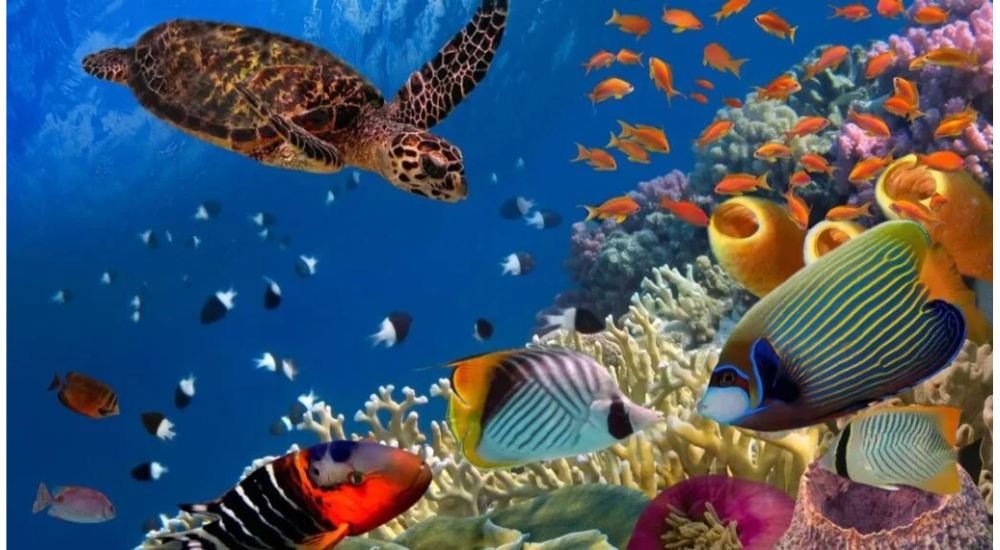Marine Life-Themed A Dive into the Wonders of the Ocean
The ocean covers more than 70% of our planet, yet it remains one of the least explored frontiers. From the tiniest plankton to the massive blue whale, marine life is full of wonders. The marine ecosystem is vast, supporting millions of species that thrive in various underwater habitats. Each organism, whether a microscopic algae or a giant squid, plays a crucial role in maintaining the balance of the oceanic environment. The ocean is not just home to these species but also contributes significantly to human life by providing oxygen, food, and climate regulation. The beauty and mystery of marine life continue to fascinate scientists and oceanographers, urging them to explore further and understand the intricate relationships between marine organisms and their habitats.
What is Marine Life?
Marine life refers to the organisms that inhabit the ocean, ranging from microscopic plankton to enormous whales. These species have adapted to life in water, developing incredible survival strategies. The vastness of the marine ecosystem includes various zones such as the sunlight zone, the twilight zone, and the abyss, each housing unique creatures with extraordinary adaptations. Some marine species, like jellyfish, have existed for millions of years, evolving to survive in extreme conditions. The diversity in marine life is astounding, with new species being discovered regularly, revealing the mysteries of the ocean.
Importance of Marine Biodiversity
Marine biodiversity is crucial for maintaining the health of ocean ecosystems. Each species plays a role in the food chain, contributes to the stability of marine environments, and supports global climate regulation. Coral reefs, for example, act as nurseries for many marine species, ensuring the continuity of marine populations. Moreover, ocean biodiversity supports human industries such as fisheries, tourism, and medicine. Many marine organisms produce compounds that are used in pharmaceuticals, offering potential cures for various diseases. Preserving marine biodiversity is essential for sustaining life on Earth, as the ocean is responsible for producing nearly half of the world’s oxygen through phytoplankton activity.
Evolution of Marine Life
The evolution of marine life dates back billions of years, beginning with simple single-celled organisms. Over time, marine species have undergone remarkable adaptations, leading to the emergence of complex creatures such as fish, cephalopods, and marine mammals. Fossil records provide insights into ancient marine ecosystems and how different species adapted to their surroundings.
Key Marine Life Adaptations
Marine organisms have evolved fascinating adaptations for survival, including bioluminescence, camouflage, and deep-sea pressure resistance. Some species, like the anglerfish, use light-producing organs to attract prey, while others, like cuttlefish, can change colors instantly to blend with their surroundings. These adaptations showcase the incredible diversity and resilience of marine life.
Coral Reefs – The Rainforests of the Ocean
Coral reefs are among the most diverse and important marine ecosystems. Found in warm, shallow waters, they provide a habitat for about 25% of all marine species. Corals are tiny animals that build massive calcium carbonate structures over centuries, forming vibrant underwater landscapes teeming with life. These ecosystems support a variety of marine organisms, from brightly colored fish and sea turtles to mollusks and crustaceans. Coral reefs also contribute to the global economy through tourism, fisheries, and coastal protection. However, they face severe threats from climate change, ocean acidification, pollution, and destructive fishing practices such as blast fishing and bottom trawling. Coral bleaching, caused by rising sea temperatures, leads to the loss of these critical habitats. Conservation efforts focus on reef restoration, sustainable tourism, and reducing human impact through marine protected areas.
The Deep Sea – A Mysterious World
The deep sea remains one of the least explored regions on Earth, yet it is home to some of the most fascinating creatures. The darkness, immense pressure, and cold temperatures make survival challenging, but marine life has evolved unique adaptations to thrive in these conditions. Some deep-sea creatures, like the anglerfish, use bioluminescence to attract prey, while others rely on hydrothermal vents for nutrients. Hydrothermal vents, found along mid-ocean ridges, release mineral-rich water that supports entire ecosystems independent of sunlight. These vents host extremophiles—organisms that can withstand extreme conditions and offer insights into the potential for life beyond Earth. Research into deep-sea ecosystems continues to reveal new species, contributing to our understanding of biodiversity and evolutionary adaptations.
Coastal Waters and Estuaries
Coastal regions, including estuaries and mangroves, serve as crucial breeding and feeding grounds for marine life. Estuaries, where freshwater from rivers meets the saltwater of the ocean, create nutrient-rich environments supporting diverse species, from fish and birds to shellfish and aquatic plants. Mangrove forests act as natural buffers against coastal erosion, providing shelter to juvenile fish and preventing storm surges. Seagrasses, often overlooked, play a significant role in carbon sequestration and offer habitat for species like sea turtles and dugongs. However, human activities such as land reclamation, pollution, and deforestation threaten these fragile environments. Protecting coastal ecosystems ensures the health of marine biodiversity and strengthens resilience against climate change.
Majestic Whales and Dolphins
Whales and dolphins, collectively known as cetaceans, are among the most intelligent and social marine creatures. These mammals use echolocation for navigation, communicate using complex vocalizations, and exhibit remarkable problem-solving abilities. The blue whale, the largest animal on Earth, can grow up to 100 feet long and plays a crucial role in maintaining marine ecosystems by recycling nutrients. Dolphins, known for their playful nature, form strong social bonds and cooperate while hunting. Despite their significance, cetaceans face threats from commercial whaling, habitat destruction, ship strikes, and underwater noise pollution. Conservation efforts, including marine sanctuaries and stricter regulations on commercial whaling, aim to protect these magnificent creatures.
Sharks – The Misunderstood Predators
Sharks have been around for over 400 million years, evolving into some of the ocean’s most efficient predators. Despite their portrayal in popular media as dangerous killers, sharks play a crucial role in maintaining marine ecosystem balance by controlling prey populations. Species such as the great white shark, hammerhead, and tiger shark are apex predators that prevent overpopulation of certain marine species, ensuring biodiversity. However, shark populations have drastically declined due to overfishing, finning, and bycatch. Conservation programs, including shark sanctuaries and fishing regulations, help protect these essential marine animals.
Tiny but Mighty – Plankton and Microorganisms
While often overlooked, plankton forms the foundation of marine ecosystems. Phytoplankton, tiny plant-like organisms, produce oxygen and serve as the primary food source for many marine species, including krill and small fish. Zooplankton, microscopic animal organisms, support the diets of larger marine creatures. Without these tiny organisms, marine food chains would collapse, leading to catastrophic consequences for ocean life. Protecting oceanic health ensures the survival of plankton and, in turn, the entire marine ecosystem.
Conclusion
Marine life is a vital part of our planet’s ecosystem, providing food, regulating the climate, and supporting biodiversity. However, human activities threaten its survival. By taking action—whether through reducing plastic use, supporting conservation efforts, or spreading awareness—we can help protect the ocean and its incredible inhabitants. The wonders of marine life continue to inspire researchers and nature enthusiasts alike, reminding us of the importance of preserving these magnificent ecosystems for future generations.
Share this content:














Post Comment